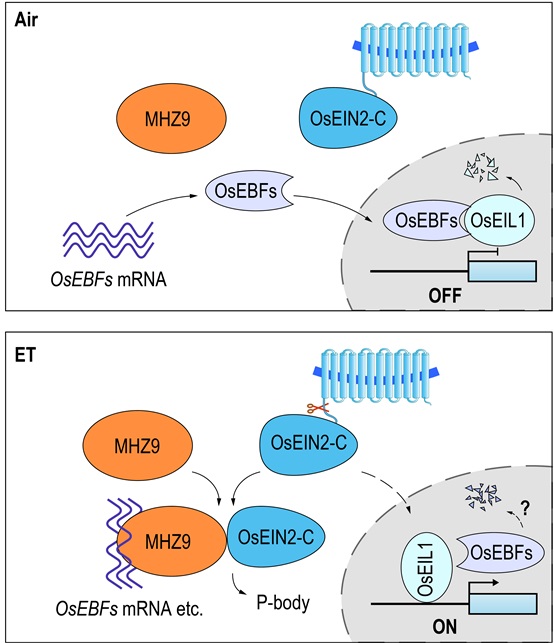Ethylene is a versatile gaseous plant hormone that plays considerable roles in rice growth, development and environmental adaptability. Translational control enables the mRNA to be translated in an mRNA-selective, signal-responsive and rapid manner. Previous studies in Arabidopsis revealed that ethylene could induce EIN2-mediated specific translation suppression of EBF1/2 mRNAs for activation of downstream signaling. However, whether any RNA-binding proteins are involved in this process remains unknown.
Recently, a team led by Professors ZHANG Jinsong at the Institute of Genetics and Developmental Biology of the Chinese Academy of Sciences, provided insights into the mechanism of translational regulation in rice ethylene signaling.
Researchers from ZHANG Jinsong's lab developed an efficient screening system and identified a set of rice mutants, mao huzi (mhz), which is a Chinese name of cat whiskers to describe the scattered adventitious roots in ethylene response mutants.
Through analysis of a rice ethylene response mutant mhz9, they identified a glycine-tyrosine-phenylalanine (GYF) domain protein MHZ9, which positively regulates ethylene signaling at translational level in rice.
They found that MHZ9 is localized in the RNA processing body (P-body). Biochemical studies further revealed that the C-terminus and N-terminus of MHZ9 play different roles. MHZ9 C-terminus contains a glutamine-rich segment, which mediates the interaction between MHZ9 and OsEIN2-C and is also sufficient and necessary for the P-body localization of MHZ9. MHZ9 N-terminus contains a predicted domain for RNA splicing/modification, and directly binds to OsEBF1/2 and many other mRNAs.
By using multiple biochemical methods, they found that MHZ9 targets OsEBF1/2 mRNA for translational inhibition upon ethylene treatment. Suppression of OsEBFs translation would reduce OsEBFs-mediated degradation of the transcription factor OsEIL1, allowing accumulation of OsEIL1 for further activation of downstream ethylene signaling events.
Next, they performed ribo-seq analysis to study the role of MHZ9 in translational regulation at the whole-genome level during ethylene response. Ribo-seq analysis indicates that 1956 genes would be significantly and differentially regulated at the translation efficiency (TE) level in response to ethylene. MHZ9 mediates the translational response of 1788 (~91%) of TE-altered genes induced by ethylene directly or indirectly.
They also observed multiple changes in phenotypes under field-grown conditions in the mhz9 mutant, including dwarf, tiller number decrease, tiller spreading, and grain size reduction, suggesting that MHZ9 may have other roles in control of agronomic traits in rice.
This study discovers a master regulator MHZ9 for translational control during ethylene response in rice (Figure 1). The MHZ9-mediated translation regulation may facilitate improvements of agronomic traits and adaptation to unfavorable environment for crops.
This work is supported by the National Natural Science Foundation of China and the State Key Lab of Plant Genomics.
Figure 1 A proposed working model for MHZ9-mediated ethylene signaling in rice (Image by IGDB). In the absence of ethylene, MHZ9 remains at low-affinity-binding states to OsEBFs mRNA. OsEBFs proteins accumulate and lead to the degradation of OsEIL1. Ethylene response is OFF. With ethylene, MHZ9 possibly receives a signal from OsEIN2-C through direct interaction, and then binds to the 3’UTR of OsEBFs mRNA and other targets for translational inhibition, which contributes to the OsEIL1 protein accumulation and downstream ethylene signaling. The residual OsEBF1/2 may decay through unknown mechanisms.
Contact:
Professors ZHANG Jinsong
Institute of Genetics and Developmental Biology, Chinese Academy of Sciences
 Figure 1 A proposed working model for MHZ9-mediated ethylene signaling in rice (Image by IGDB). In the absence of ethylene, MHZ9 remains at low-affinity-binding states to OsEBFs mRNA. OsEBFs proteins accumulate and lead to the degradation of OsEIL1. Ethylene response is OFF. With ethylene, MHZ9 possibly receives a signal from OsEIN2-C through direct interaction, and then binds to the 3’UTR of OsEBFs mRNA and other targets for translational inhibition, which contributes to the OsEIL1 protein accumulation and downstream ethylene signaling. The residual OsEBF1/2 may decay through unknown mechanisms.Contact:Professors ZHANG JinsongInstitute of Genetics and Developmental Biology, Chinese Academy of SciencesEmail: jszhang@genetics.ac.cn
Figure 1 A proposed working model for MHZ9-mediated ethylene signaling in rice (Image by IGDB). In the absence of ethylene, MHZ9 remains at low-affinity-binding states to OsEBFs mRNA. OsEBFs proteins accumulate and lead to the degradation of OsEIL1. Ethylene response is OFF. With ethylene, MHZ9 possibly receives a signal from OsEIN2-C through direct interaction, and then binds to the 3’UTR of OsEBFs mRNA and other targets for translational inhibition, which contributes to the OsEIL1 protein accumulation and downstream ethylene signaling. The residual OsEBF1/2 may decay through unknown mechanisms.Contact:Professors ZHANG JinsongInstitute of Genetics and Developmental Biology, Chinese Academy of SciencesEmail: jszhang@genetics.ac.cn CAS
CAS
 中文
中文




.png)
